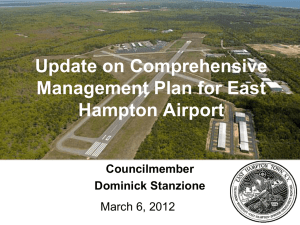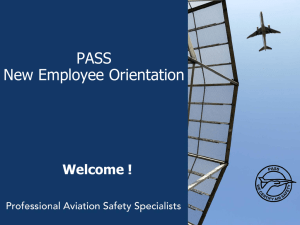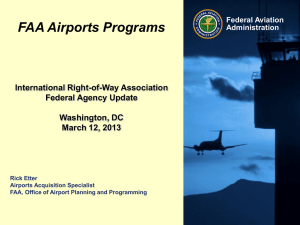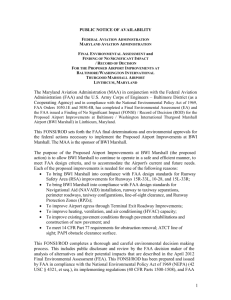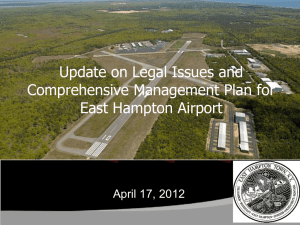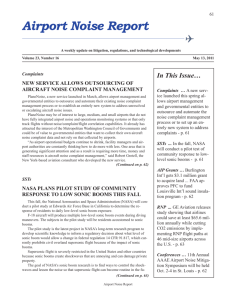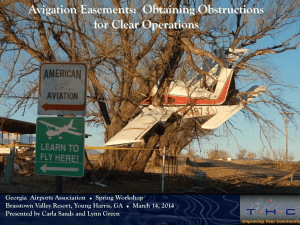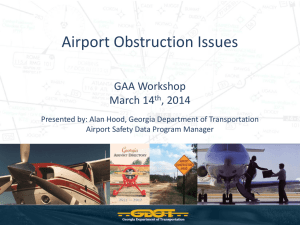Comprehensive Management Plan
advertisement
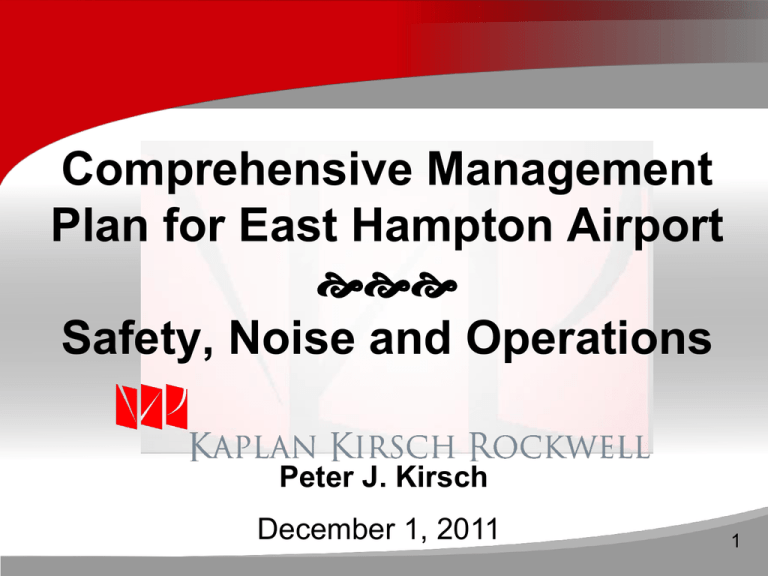
Comprehensive Management Plan for East Hampton Airport Safety, Noise and Operations Peter J. Kirsch December 1, 2011 1 Today’s Presentation Review basic principles Explain Councilman Stanzione and staff’s work on preparing comprehensive management plan Discuss immediate steps Outline possible elements of a management plan 2 Basic legal principles 1. 2. 3. Town is currently ‘grant obligated’ to FAA Most obligations (34) expire in 2021 FAA has agreed not to enforce two after 2014 Three are permanent so long as Airport is open Town’s ability to address noise and safety issues is not significantly affected by FAA grants, but is affected by cooperation with FAA There is considerable legal uncertainty about what would happen in 2021 with no new FAA grants; resolving that uncertainty would cost millions in litigation 3 Developing the management plan Councilman Stanzione, working with staff, consultants, and counsel to draft management plan to address safety, noise and airport operations Effective, comprehensive and aggressive Adopt best practices at other airports that accept FAA grants Focus first on next six months Some measures require FAA cooperation 4 Mr. Stanzione’s suggested assumptions 1. 2. 3. 4. 5. 6. 7. 8. The Airport must be a good neighbor All reasonable measures should be considered Examine what can be implemented immediately Plan should be comprehensive, dealing with Airport management in broad terms, across professional disciplines, including noise Measures should each be cost effective (recommend the most effective and least costly measures first) Program should be evaluated to determine whether to proceed to next step; use Town-established metrics Program should be financially sustainable No physical expansion of the Airport 5 Comprehensive management Noise Safety Operations Finances 6 Current status This Board has invested 18 months to build a solid foundation for the management plan ALP submitted and approved Established cooperative relationship with FAA Led regional effort to address helicopter routes Approved funding for seasonal control tower Hired engineer to develop plan for tower Negotiated with FAA over airspace 7 Proposed immediate relief Continue process for FAA approval of Class D airspace (immediate) 2. Finalize contract for control tower (Robinson) (15 days) 3. Secure FAA funding commitment (30 days) 4. Finalize management program (30 days) 5. Formalize protocol and technology for collecting noise and safety data (begin within 30 days) 6. Adopt new Town policy on role of Airport (30 days) 7. Develop strategy and timetable for implementing helicopter restrictions (60 days) 8. Install temporary seasonal tower (90 days) 9. Start formal Part 161 process for a helicopter curfew (180 days) 1. 8 “Stair Step” implementation For each future initiative, evaluate: •What is the cost? •How easy is it to implement? •How effective is it, using established metrics? •Should we take the next step? 9 Categories of 44 possible measures Group I – Rules and regulations (12 measures) Group II – Mandatory operational rules (5 measures) Group III – Voluntary measures (11 measures) Group IV – Capital improvements and facility modifications (8 measures) – 1 already implemented Group V – Noise mitigation measures (3 measures) Group VI – Flight tracks and procedures (5 measures) 10 Group I – Rules and regulations 1. 2. 3. 4. 5. Adopt revised Town policy on mission of Airport, and on safety and community impact objectives Conduct inventory of existing rules, regulations and minimum standards Research best practices for similar airports Revise rules and regulations to accord with best practices Enforce rules and regulations in accord with best practices 11 Group I Revise minimum standards as appropriate 7. Revise rates and charges as appropriate 8. Assess availability of services at night 9. Adopt ground movement rules 10. Evaluate engine run-up rules 11. Reassess revenue scheme 12. Reevaluate landing fees 6. 12 Group II – Mandatory operational rules 1. 2. 3. 4. 5. Restrict Stage I aircraft Restrict Stage II aircraft and helicopters Restrict Stage III aircraft Adopt mandatory nighttime curfew Time of day restrictions 13 Group III – Voluntary measures 1. 2. 3. 4. 5. 6. Research similar airports’ best practices: voluntary measures, rates and charges, operational rules Evaluate success of voluntary curfew Increase hours of curfew Develop ‘fly quiet’ good-neighbor program Create web-based noise reporting Develop communications program to discourage night operations 14 Group III Adopt ‘carrot-and-stick’ program about night operators 8. Design temporary or permanent noise monitoring systems 9. Enhance noise event reporting 10. Implement monetary reward system for compliant operators 11. Establish oversight or advisory committees on management issues (including noise) 7. 15 Group IV – Capital projects 1. 2. 3. 4. 5. 6. 7. 8. Establish permanent air traffic control tower Work with FAA to permanently (not seasonally) commit facilities for protected HTO airspace Review facilities that increase Town control over terminal and ground operations Improve airfield lighting Install ILS or similar instrumentation Modify airfield geometry Install noise barriers Establish dedicated helipads 16 Group V – Noise mitigation 1. 2. 3. Land acquisition Sound attenuation/ insulation Prepare FAA-funded Part 150 Noise Compatibility Program 17 Group VI – Flight procedures 1. 2. 3. 4. 5. Adopt preferential runway use program Adopt mandatory flight tracks Establish noise abatement departure profile Create, communicate, and enforce new South Shore helicopter route Establish Class D airspace 18 Next Steps: Prepare plan Begin immediate implementation Seek Town Board input on overall plan Priorities in Town’s best interest Measures Metrics for evaluating success Funding and cost thresholds Refine initial list of tactics into an effective management program Seek direction on further steps 19 Questions Peter J. Kirsch pkirsch@kaplankirsch.com www.airportattorneys.com 20
